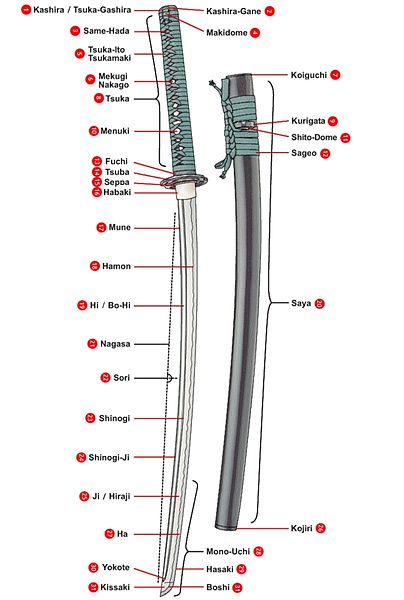
The sword’s length is measured from this notch to the point of the sword in a straight line. Mune-machi–The mune-machi is the notch on the back of the sword that marks the beginning of the tempered edge. This is the beginning of the sword’s tempered edge. Ha-machi– The ha-machi is a notch located on the front of the sword. It is unsharpened and will have one or two peg-holes, called mekugi-ana. Nakago– The nakago is the tang, the part of the blade that fits inside of the handle. It is said the hi makes a certain type of noise when the sword is swung perfectly, so some would use it as a guide.

It lightens the blade, which takes some power out of the sword’s blows. Hi–The hi is an optional groove that goes down the shinogi-ji on both sides.

Ha–The ha is the sharpened, cutting edge. Ji–The ji is the surface between shinogi and hamon. Shinogi–The shinogi is the line separating the shinogi-ji from the hada. Hada–The hada is the middle part of the blade. Shinogi– ji–The shinogi-ji is a flat ridge on the blade’s back. Blades are differentially hardened to allow shock absorption and avoid brittleness. Yakiba–The yakiba is the hard part of the blade, the cutting edge. Yokote–The yokote is the line that separates the kissaki from the rest of the blade. Their shapes can differ from the hamon, but they are usually similar. There are different types of hamon, with different names.īoshi–The boshi is the part of the hamon that covers the kissaki. The swordsmith decides how it is shaped, making it a distinctive part of each blade. Hamon–The hamon is a line formed during the tempering process. Kissaki– The kissaki is the end of the blade, where the sharpened edge curves to a point. This Katana terminology guide will help readers to learn the different names of the Katana parts, and how they go together. The material of custom blades could include Maru ( T10 Steel Clay Tempered, Damascus Steel, Damascus Steel Clay Tempered and Wootz Steel Clay Tempered), Honsanmai (Hagane steel for the sword's edge, Shingane steel for the core and Kawagane steel for the exterior of blades), Gomai ( Hagane + Shingane ), Soshu Kitae ( Hagane + Kawagane + Shingane) and Kobuse.Learning about Katana parts can be overwhelming with all of the Japanese terminology involved.

The most important part of a katana is the blade, how much does a katana blade cost depends on lost factors like the materials, swordsmith skills, time of forging, etc. The rope on the Saya is called Sageo, Sageo is a cord that was traditionally used to secure the scabbard of a Katana to the belt of the person who will wield it. Saya is normally manufactured from very lightweight wood, with a coat of lacquer on the exterior, and it can also be made from very precious wood or metal. The katana scabbard can hold the blade inside safely and keep it as fresh as possible, the Japanese name is called Saya. The Habaki is a piece of metal encircling the base of the blade which is used to lock the tsuba in place and to maintain the blade in its saya. The guard we talked about above is called the Tsuba, it can be made of iron, alloys, brass and copper, etc. And you can also see the two little bamboo pegs that are used to help secure the handle is called mekugi. The inside is ray skin and normally in white colour which guarantees a very good grip. The handle wrapping is commonly referred to as Tsuka-Ito, it is made of premium cotton or silk and comes in different colours. The handle of the katana is made of wood we call Tsuka, you'll hold it at the top next to the guard. A katana is consist of various parts, and let's see the most basic parts in this article for a beginner.


 0 kommentar(er)
0 kommentar(er)
